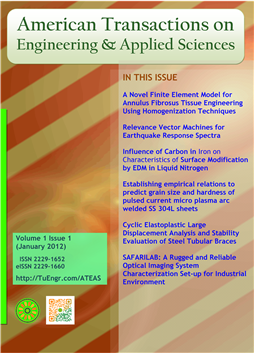- V4(4)Oct2015
- V4(3)Jul2015
- V4(2)Apr2015
- V4(1)Jan2015
- V3(4)Oct2014
- V3(3)Jul2014
- V3(2)Apr2014
- V3(1)Jan2014
- V2(4)Oct2013
- V2(3)Jul2013
- V2(2)Apr2013
- V2(1)Jan2013
- V1(4)Oct2012
- V1(3)Jul2012
- V1(2)Apr2012
- V1(1)Jan2012
:: Vol.1(1) (January 2012)

:: American Transactions on Engineering & Applied Sciences
http://TuEngr.com/ATEAS

ISSN 2229-1652
eISSN 2229-1660
FEATURE PEER-REVIEWED ARTICLES
|
Keywords: Finite Element Method, Annulus Fibrosus, Tissue Engineering, Homogenization.
Abstract
In this work, a novel finite element model using the mechanical homogenization techniques of the human annulus fibrosus (AF) is proposed to accurately predict relevant moduli of the AF lamella for tissue engineering application. A general formulation for AF homogenization was laid out with appropriate boundary conditions. The geometry of the fibre and matrix were laid out in such a way as to properly mimic the native annulus fibrosus tissue’s various, location-dependent geometrical and histological states. The mechanical properties of the annulus fibrosus calculated with this model were then compared with the results obtained from the literature for native tissue. Circumferential, axial, radial, and shear moduli were all in agreement with the values found in literature. This study helps to better understand the anisotropic nature of the annulus fibrosus tissue, and possibly could be used to predict the structure-function relationship of a tissue-engineered AF.
|
Keywords: Response spectrum, Ground motion, Supervised learning, Bayesian regression, Relevance Vector Machines
Abstract
This study uses Relevance Vector Machine (RVM) regression to develop a probabilistic model for the average horizontal component of 5%-damped earthquake response spectra. Unlike conventional models, the proposed approach does not require a functional form, and constructs the model based on a set predictive variables and a set of representative ground motion records. The RVM uses Bayesian inference to determine the confidence intervals, instead of estimating them from the mean squared errors on the training set. An example application using three predictive variables (magnitude, distance and fault mechanism) is presented for sites with shear wave velocities ranging from 450 m/s to 900 m/s. The predictions from the proposed model are compared to an existing parametric model. The results demonstrate the validity of the proposed model, and suggest that it can be used as an alternative to the conventional ground motion models. Future studies will investigate the effect of additional predictive variables on the predictive performance of the model.
|
Keywords: EDM, Surface modification, Titanium nitride, Liquid nitrogen
Abstract
Many surface modification technologies have been proposed and carried out practically by CVD, PVD et.al. Carbonized layer has been made using EDM method. In this paper, to make the nitride layer by EDM some new trials were carried out using a titanium electrode in liquid nitrogen. Experiments were carried out on carbon steel (S45C), pure iron and cast iron. TiN can be obtained on EDMed surface. Moreover, TiCN can be found on cast iron and steel (S45C) by XRD investigation. To confirm the fabrication mechanisms of modified layer on the steel, the following experimental factors were investigated by EDS.
|
Keywords: Geldart particle; Downer reactor; Simulation; CFD; Two-fluid model.
Abstract
The purpose of this research is to study the effect of Geldart A and C particles on the hydrodynamics behavior in a 9.3 m height, 0.1 m diameter co-current downflow circulating fluidized bed (downer reactor) using CFD simulation. Two-fluid model with kinetic theory of granular flow was adopted to predict flow behavior in the system. The simulation results show that hydrodynamics behavior in the downer strongly depends on the type of the particle. Geldart C particle exhibits a more uniform distribution along the lateral direction as compared with Geldart A particle. In addition, the effects of operating conditions were also studied. The uniformity of lateral direction of solids fraction increases with decreasing of solids circulation rate (Gs) or increasing of inlet superficial gas velocity (Ug). However, the radial distributions of gas and solids velocity are more uniform when Ug decreases especially for Geldart C particle.
|
Keywords: Cyclic, Elastoplastic, Large displacement, Analysis, Stability, Steel, Tubular, Brace, Finite-Element.
Abstract
This paper deals with the cyclic elastoplastic large displacement analysis and stability evaluation of steel tubular braces subjected to axial tension and compression. The inelastic cyclic performance of cold-formed steel braces made of circular hollow sections is examined through finite element analysis using the commercial computer program ABAQUS. First some of the most important parameters considered in the practical design and ductility evaluation of steel braces of tubular sections are presented. Then the details of finite element modeling and numerical analysis are described. Later the accuracy of the analytical model employed in the analysis is substantiated by comparing the analytical results with the available test data in the literature. Finally the effects of some important structural and material parameters on cyclic inelastic behavior of steel tubular braces are discussed and evaluated.
|
Keywords: Incoherent imaging systems, Characterization, Spatial Frequency Response, Modulation Transfer Function, ISO 12233
Abstract
This work proposes a rugged and reliable set-up to characterize incoherently illuminated optical imaging systems. It complies with the ISO 12233 standard and is suitable for industrial applications. The standard has been implemented taking advantage of the allowed degrees of freedom to optimize noise robustness. Key points of the algorithm are automatization of the whole measurement procedure and customization, to comply with specific needs. Experimental results confirming the successful implementation are presented and discussed.
 Issue V1(1) January 2012
Issue V1(1) January 2012ATEAS's Home ......... Next: Vol 1(2) April 2012
Call-for-Papers
Call-for-Scientific Papers
Call-for-Research Papers: ATEAS invites you to submit high quality papers for full peer-review and possible publication in areas pertaining engineering, science, management and technology, especially interdisciplinary/cross-disciplinary/multidisciplinary subjects.
To publish your work in the next available issue, your manuscripts together with copyright transfer document signed by all authors can be submitted via email to Eic @ TuEngr.com (no space between). (please see all detail from Instructions for Authors)
Publication and peer-reviewed process:
After the peer-review process (4-10 weeks), articles will be on-line published in the available next issue. However, the American Transactions on Engineering, & Applied Sciences cannot guarantee the exact publication time as the process may take longer time, subject to peer-review approval and adjustment of the submitted articles.
.
:: 2012 Rights Reserved
:: American Transactions on Engineering and Applied Sciences





